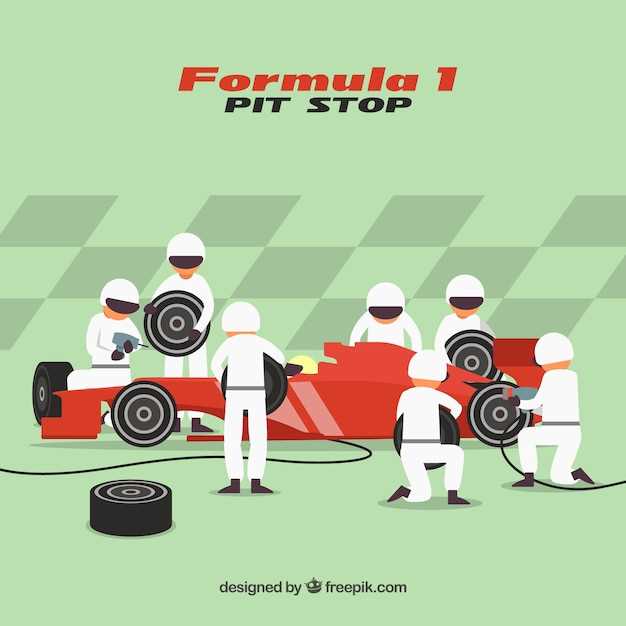
In the fast-paced world of motorsports, the difference between victory and defeat often hinges on the efficiency of a team’s pit stop. A quick pit stop is not just about speed; it embodies precision, teamwork, and effective training. The goal is simple: to minimize downtime while maximizing performance, allowing drivers to return to the race with an edge over the competition.
To achieve this level of excellence, teams must focus on comprehensive training that encompasses every aspect of the pit stop process. Individual roles must be clearly defined, and each team member needs to understand their responsibilities. From the tire changers to the fuelers, every second counts. Effective communication is the backbone of any successful pit stop, and teams must practice relentlessly to ensure seamless coordination during the heat of the moment.
An investment in regular training sessions not only improves the team’s technical skills but also fosters a culture of collaboration and trust. When every member of the team is well-prepared, the chances of executing a flawless pit stop increase significantly. This article will explore key strategies for training your team, the importance of simulation, and how continuous improvement can lead to exceptional pit stop performance on race day.
Optimizing Roles for Each Team Member During a Pit Stop
In a racing environment, every second counts, and optimizing the roles of each team member during a pit stop is crucial for achieving quick and efficient performance. Proper training ensures that each individual understands their specific responsibilities, allowing the team to operate like a well-oiled machine.
First, it is essential to define clear roles for each position. The tire changers should be trained to work rhythmically, ensuring that tire replacement occurs seamlessly. Each crew member should know not just their tasks but also the overall sequence of the pit stop, minimizing confusion and delay.
The jack operator plays a pivotal role, as their timing and precision directly affect the speed of tire changes. Training should focus on quick lifting techniques and coordination with tire changers. Implementing rigorous drills can enhance their ability to respond swiftly to dynamic situations.
Moreover, the fuel crew must maintain their focus on efficiency. Proper training on handling fuel equipment and timing is vital. Each member needs to be aware of safety protocols while achieving maximum speed in refueling. Reliability in this role minimizes the time the car spends in the pit.
The car chief must coordinate all activities, ensuring that communication flows effectively among team members. This role requires an understanding of each position, as well as decision-making skills to adapt to changing circumstances during a pit stop. Training in leadership and crisis management can significantly enhance performance.
To maximize the team’s overall effectiveness, regular practice sessions should be scheduled. This allows the team to refine their skills and adjust roles based on individual strengths and weaknesses. Conducting timed pit stop simulations can help identify areas for improvement and foster a culture of continuous learning.
In conclusion, every team member’s role during a pit stop is crucial for success. By focusing on targeted training and clearly defining responsibilities, teams can optimize performance, ultimately leading to faster pit stops and improved race outcomes.
Implementing Time-Tracking Techniques for Improved Performance

In the fast-paced environment of competitive motorsports, every second counts during pit stop operations. Implementing effective time-tracking techniques is essential for optimizing team performance and ensuring swift execution during these critical moments. Time tracking allows teams to monitor their processes, identify delays, and refine strategies to achieve quick pit stops.
One fundamental technique is the use of stopwatches or digital timers to measure each phase of the pit stop. Breaking down the process into specific segments–such as tire changes, fuel refills, and adjustments–enables teams to analyze performance metrics for each segment. By maintaining detailed records, teams can gather valuable data to assess areas for improvement.
Utilizing video analysis can further enhance understanding of pit stop dynamics. High-speed cameras can capture each pit stop, allowing teams to review footage for inefficiencies or mistakes. This method facilitates real-time feedback and enables team members to visually identify areas where time can be saved, promoting a culture of continuous improvement.
Additionally, leveraging technology such as GPS trackers and performance measurement tools can provide real-time insights into each team member’s movements during a pit stop. By mapping out precise movements, teams can strategize optimized workflows, reducing unnecessary steps and minimizing time spent in the pit.
Regular training sessions incorporating these time-tracking techniques are vital. Simulating different scenarios during practice allows team members to become accustomed to the pressures of real pit stop situations while reinforcing the importance of time efficiency. Team drills focused on time tracking raise awareness of individual responsibilities and encourage better coordination among team members.
Lastly, analyzing historical data and comparing performance over time can highlight trends and motivate teams to set achievable targets. Tracking progress towards these goals fosters a competitive spirit and cultivates a sense of accountability within the team, ultimately enhancing overall performance during critical pit stop moments.
Conducting Regular Drills to Enhance Coordination and Speed

Regular drills are essential for honing the skills required during pit stops. These training sessions allow team members to practice their specific roles, ensuring that everyone understands their tasks and the importance of timing. Consistent repetition fosters muscle memory, which is crucial for enhancing overall speed.
Each practice session should simulate real race conditions, focusing on both coordination and communication among team members. Participants can work on their individual responsibilities, such as tire changes, refueling, and adjustments, while simultaneously learning to anticipate the actions of their teammates. This heightened awareness is vital in reducing the time spent during a pit stop.
Setting clear goals for each drill can improve performance significantly. Teams should track their progress over time, aiming to decrease their pit stop duration with each session. Using timing equipment can provide immediate feedback, motivating team members to push their limits and encourage a culture of excellence.
Introduce various scenarios to keep drills engaging and to challenge the team’s adaptability. These exercises can include unexpected circumstances like a tire malfunction or a delayed refueling process. Training under diverse conditions prepares the team to respond effectively, ensuring they can maintain speed and coordination during an actual race.
In summary, regular drills focused on coordination and speed are fundamental for any team aiming for quick pit stop excellence. By creating a structured training environment that emphasizes practice, communication, and adaptability, teams can significantly enhance their performance on race day.



